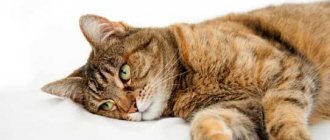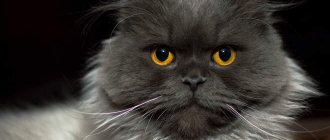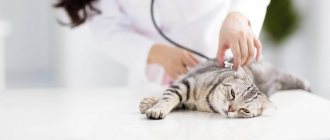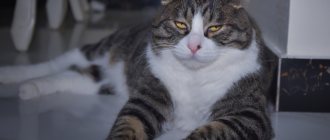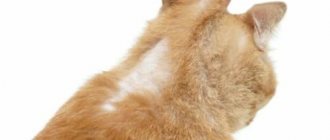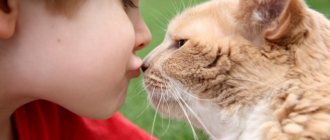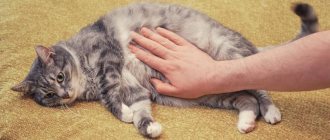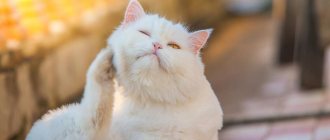A state of decreased functionality of the gastrointestinal tract - intestinal atony in cats is manifested by disturbances in digestion and excretion of waste products. The disease is caused by internal pathological processes, the creation of improper conditions for keeping the animal, or damage to the pelvic organs. If you contact a veterinarian in a timely manner, the animal’s health will be fully restored.
Causes of pathology
Atony in cats develops due to a weakening of the intestinal muscles and a decrease in the activity of digestive processes with a gradual increase in the difficulty of defecation.
Veterinarians identify the main causes of the disease:
- hereditary predisposition;
- congenital disorders of intestinal development and formation in kittens;
- natural aging of the body and weakening of muscles;
- diseases of the endocrine system;
- improper feeding;
- blockage of intestines with fur;
- lack of fiber in food;
- low physical activity;
- intestinal infections;
- extensive helminth infestation;
- malignant neoplasms;
- overfeeding, obesity;
- inflammatory diseases of the stomach.
Failure to comply with pet hygiene rules can cause illness.
The following factors have additional adverse effects:
- adhesions as a result of surgery;
- taking and side effects of medications;
- psychological tension and stress;
- a dirty litter tray and the cat’s reluctance to empty itself;
- decreased intestinal vascular tone.
The essence of the problem
In the stomach of each animal there is a continuous production of large quantities of digestive juices. This process is absolutely independent of food intake, and also occurs during prolonged fasting. The main function of the intestines is to push the bolus of food towards the anus. As they progress, digestive juices are absorbed back through the walls, but with nutrients.
These are the basics of physiology so that the reader can imagine what happens in the body when there is intestinal obstruction in a cat. Symptoms develop rapidly also for the reason that digestive juice is produced in the same volume, but cannot be absorbed along with nutrients. In response, vomiting occurs to relieve excess pressure on the tissue.
Why can intestinal obstruction develop in cats? Symptoms and treatment will directly depend on what led to this complication. Often this is not the disease itself, but only a symptom of some illness. Let's list the main reasons that can lead to such a development:
A foreign body that has blocked the intestinal lumen. This is a fairly common variant of intestinal obstruction. Cats, and especially kittens, can swallow candy wrappers and threads, tinsel and New Year's "rain"
As a result, the food bolus cannot move further. Owners of long-haired cats should pay special attention to this problem. By licking their fur, they eat a sufficient amount of it
If a lot of it accumulates in the intestines, the wool gathers into a lump and clogs the passage. It is worth noting separately that in this case, owners often give their pets laxatives. This should not be done, as intestinal rupture may occur. Intestinal obstruction in cats may be associated with helminthic infestation. Intestinal parasites gather in a large lump and block the exit. Of course, it is difficult to imagine such an outcome for a home-made, well-groomed intestine that is regularly taken to the veterinarian for examination. Constipation. Improper feeding often leads to this unpleasant phenomenon. At first glance, this is not a very serious complication. But hard and dry feces form a kind of plug and lead to intoxication of the body. Malignant formations. Intestinal volvulus. In this case, the animal will also not be able to get rid of feces. The worst thing in this case is that the compressed area of the intestine is not supplied with blood, which leads to the development of tissue necrosis. If you perform surgery and empty the intestines, the toxins will quickly spread throughout the body and death will occur.
Symptoms of the disease
A decrease in the activity of the intestines and stomach in cats is manifested by disruption of digestive processes and a further deterioration of the general condition. Main symptoms of atony:
- decreased appetite;
- vomit;
- decreased intestinal motility;
- significant reduction in feces excreted;
- change in consistency and addition of an unpleasant odor from feces;
- weakness, lethargy.
One of the symptoms of the disease is a significant increase in the abdominal cavity.
Obstruction in cats causes the following symptoms:
- abdominal tension;
- lack of appetite, refusal of any food;
- sagging abdomen;
- weight loss;
- deterioration of coat condition;
- blanching of mucous membranes;
- aggressive reaction when touching the stomach due to pain.
How can you tell if your cat is constipated?
A healthy animal defecates once a day, sometimes slightly less often or more often, which is associated with the food consumed. In this case, defecation occurs quickly, without causing pain in the pet. Feces are soft and uniformly smooth, without cracks or lumps.
If attempts to go to the litter box are frequent, but mostly unsuccessful, the process is apparently unpleasant for the cat, and the feces are hard and dry, you should contact a veterinarian.
In this case, additional signs of the pathological condition are:
- loss of appetite and weight;
- lethargy and apathy;
- tension in the pet’s abdomen and swelling of the anus;
- vomiting, especially white foam;
- painful urge to defecate, the cat squats and strains painfully, and may meow.
Diagnostics
To determine treatment tactics, it is necessary to find out the cause of atony. A veterinarian performs a visual examination of the cat with palpation of internal organs. The diagnosis is based on pathological history, laboratory and instrumental diagnostic methods. Basic laboratory tests:
- Blood chemistry. A detailed study of the work of internal organs.
- Coprogram. Stool analysis assessing the functioning of the digestive and excretory systems and the presence of parasites.
Instrumental diagnostics includes the following examinations:
- Radiography. The organs of the gastrointestinal tract and intestinal structures are visualized.
- Ultrasound diagnostics (ultrasound). Checking the condition and contents of internal organs.
- X-ray with contrast. The work of the intestines is examined one by one after the administration of barium sulfate (jejunum, cecum and colon after 4-6 hours, rectum after 7).
- Diagnostic laparotomy. A surgical intervention that identifies damage to the digestive organs through an incision in the abdominal wall.
Starvation diet
In general, this is the easiest and most accurate way to treat an upset stomach in a cat. Even the cat himself, when he feels that something is wrong with his stomach, voluntarily refuses food. The animal completely loses its appetite and eats only after its insides stop “signaling” about the disorder. However, during the time of domestication, cats lost their brakes somewhat and some animals, even when they are vomiting and have severe diarrhea, are still not averse to eating a bowl or two of food. And these desires of the pet should be sharply limited.
Just remove his bowl and hide all food from the table for about a day. When the cat is forced to starve, please take care of his unhindered access to any amount of clean drinking water. The pet must satisfy its thirst at any time. But! Cats should only be left without food for a day at a time. After this period, you can start giving them food, but only in small quantities, gradually.
If an animal eats heavily after fasting, it is highly likely that it will begin to vomit or develop profuse diarrhea. As for kittens. While adult cats can fast for 24 hours, small kittens cannot go that long without food. The maximum duration of fasting in this case is four hours (for the whole day).
After fasting, the animal is put on a gentle diet. You should feed the cat 4-6 times a day, in small portions. This should continue for five to seven days. What should you give your pet at this time? Ideally, you should use boiled chicken, cottage cheese and rice, as well as baby formula for this. These foods have the least impact on your pet's gastrointestinal tract.
As soon as the cat stops vomiting, she has formed normal feces, she is gradually, over three to four days, transferred to a normal diet. If you do this too harshly, there is a high chance that your cat's diarrhea will return.
Treatment of pathology
After examination and medical history, the specialist selects a treatment method.
The choice of methods for treating intestinal atony in cats depends on the cause of defecation difficulties, the duration and severity of manifestations, the age of the animal and concomitant diseases. The veterinarian chooses from the following treatment methods:
- therapeutic nutrition;
- administering enemas with an antiseptic;
- administration of medications;
- surgical intervention.
The therapeutic diet is based on enriching the diet with fiber to stimulate digestive processes and irritate intestinal receptors. The veterinarian selects the appropriate ready-made food in accordance with the clinical picture. If the cat has eaten natural food, the doctor draws up a menu for the treatment period. Additional gentle means to facilitate bowel movements are:
- specially grown medicinal herbs (sold at a veterinary pharmacy);
- Vaseline oil;
- fiber in the form of dietary supplements.
The main means of therapy and their effects are presented in the table:
| Group of drugs | Therapeutic effect |
| Prokinetics | Stimulates intestinal contractions |
| Strengthens the functioning of the excretory system | |
| Laxatives | Liquefies feces |
| Increase intestinal activity | |
| Gastroprotectors | Protects the gastric mucosa |
| Increases resistance to external irritants | |
| Probiotics | Restore intestinal microflora |
| Antispasmodics | Remove spasms |
| Antibiotics | Eliminate infectious pathogens |
| Analgesics | Relieves pain |
| Anthelmintic | Destroy and remove parasites |
In some cases, the only treatment option is surgery.
If atony in cats is caused by fecal stones, malignant neoplasms, congenital malformations of the excretory system, or the intestines are clogged with helminths, surgical intervention is performed to eliminate the negative factors that interfere with the natural process of defecation.
Inflammation of the colon in cats.
When a cat's colon (also called colon) becomes diseased (due to parasites or other reasons), diarrhea usually develops. Cats with colonic inflammation
usually have difficulty defecating and mucus in the stool, sometimes containing bright red blood. Feces are often small in volume and more liquid than normal. Nausea is observed in approximately 30% of cases, and weight loss is rare.
If possible, it is necessary to identify and eliminate the cause of the inflammation. When treating, strictly follow your veterinarian's recommendations regarding your cat's diet. For example, it may be suggested that you don't feed your cat for 24 hours to rest the cat's digestive system. When feeding is resumed, it is often recommended to add soluble fiber to the diet. Gradually, the amount of fiber can be reduced or fiber can be completely eliminated from the cat's diet. For the first time after re-feeding, it may be recommended to replace the protein source with one that the cat has not previously eaten, such as mutton, lamb, venison or rabbit. This is done to identify foods that cause food allergies in your cat. For some types of inflammation, it may be enough for cats to change their diet for treatment (for example, switch to lamb food with rice, or other ready-made medicated food). To quickly eliminate the symptoms of the disease, in addition to changing the diet, anti-inflammatory medications may be prescribed. Some cats require additional short-term medication to thicken the stool until the inflammation is under control.
Prevention of atony
To prevent difficulties in the digestive system and bowel movements, veterinarians at various clinics recommend that the cat owner follow the following rules:
- Feed the animal with high-quality feed or products.
- Ensure the supply of all necessary nutrients.
- Avoid hypothermia and stressful situations to normalize the animal’s psycho-emotional state.
- Be sure to play with your cat to increase muscle tone and physical health.
- Maintain cleanliness of the pet's premises and personal belongings.
A prerequisite for maintaining the health and well-being of a cat is the regularity and timeliness of preventive examinations, vaccinations and deworming. If negative symptoms occur, it is important to seek professional help and treat any underlying conditions.
Constipation in cats.
Constipation
are a common problem in cats.
Constipation is generally quite easy to deal with. However, in cats with more severe cases, symptoms may be severe. The longer fecal matter remains in the colon, the drier and tougher it becomes and the more difficult it is to pass. Obstipation
is systematic constipation that is difficult to treat.
Long-term constipation may be due to obstruction within the intestine, narrowing of the intestine from external influences, or neuromuscular problems in the colon itself. Obstruction is the most common cause, usually due to the inability to move indigestible, often hard substances (eg, hair, bones) that become mixed with fecal matter. Some cats with long-term constipation or constipation may experience megacolon, an enlargement of the intestines due to weakening of the intestinal muscles. The cause of megacolon often remains unclear. Some medications may cause constipation, among their side effects.
Symptoms of constipation include difficulty defecating and hard and dry stool. Some cats experience lethargy, depression, loss of appetite, nausea, and abdominal discomfort.
Cats suffering from constipation should drink more water. Mild constipation can often be relieved by placing the cat on a high-fiber diet, providing constant access to water, and using (usually short-term) appropriate laxatives. It is clear that laxatives should only be used as prescribed by a veterinarian, as human medications for cats can be extremely dangerous. In severe cases, veterinarians may remove feces with an enema or other means while the cat is under general anesthesia. Cats with chronic constipation or megacolon that do not respond to conventional treatment may benefit from surgery to remove the affected section of the colon.
You can read more about constipation in cats in a separate article.
Emergency surgery for volvulus and rehabilitation therapy
If the lesion is extensive, the veterinarian will suture the small intestine until it is completely removed, and this creates new problems. It is in the small intestine that the main process of food digestion and absorption of vitamins and microelements occurs. Even if the animal survives the operation, it will require a long recovery, a lifelong diet and regular courses of maintenance therapy.
After the operation, the cat is prescribed antibiotics that act on a wide range of microorganisms and strong painkillers that kill the already damaged intestinal microflora. Partial compensation for microflora losses is possible by prescribing probiotics and a strict diet. At the same time, they eliminate the consequences of septic and hypovolemic shock, intoxication, and blood loss.
After surgery, most often, the cat cannot feed on its own. Based on the animal’s condition, the veterinarian installs a catheter to introduce liquid food directly into the stomach. There are 2 options:
A flexible latex tube is inserted through the nose and throat to supply liquid nutrition.
A hole is cut in the abdominal cavity (artificial fistula) and fixed with a dilator (prevents healing of the wound), food is introduced directly into the intestine.
The ligaments (mesentery) are carefully untwisted, and areas in which the process of necrosis has already begun are removed. If necrosis affects most of the small intestine, it is completely removed. There are cases when the animal cannot be saved, and it is euthanized during the operation.
How to treat a cat after surgery? Drug therapy, including the use of antibiotics, will be required. This is required to prevent complications after surgery and prevent the development of infections. To prevent the formation of adhesions and alleviate the animal’s condition, Prednisolone injections are prescribed.
After surgery, the cat is not fed for 24 hours.
To normalize the water-salt balance in the body, salt solutions are used: Normofundin G-5, Ringer-Locke solution, Glycosteril, etc. Be sure to give the animal strong painkillers for several days, for example, Baralgin. As maintenance therapy, vitamin B12 is administered intramuscularly. To maintain enzyme levels, Panzinorm and Essentiale are prescribed.
The first day after surgery, the cat should not be fed or watered. Only intravenous glucose administration is possible
It is important to strictly maintain sterility to prevent infection. Immediately after surgery, the animal cannot feed on its own, so liquid food must be administered through a catheter.
Moreover, it can be administered either through the pharynx or nose, or directly into the abdominal cavity (artificial fistula).
intestinal disorder in kittens
Only registered users have the ability to start new topics. Register and log in to the site by entering your username and password on the right side of the window, and you can start a new topic.
Before visiting the forum, read the topic: “How to consult a veterinarian correctly,” as well as the list of answers to frequently asked questions, this will help you save your time and get an answer to your question faster
Pay special attention to the document: Symptoms of animal diseases. Perhaps in your situation you cannot expect an answer on the forum, but you need to urgently call a doctor or take the animal to a veterinary clinic!
Before joining the forum, read the following sections, this will help save your time and quickly get an answer to your question:
Attention! Pay special attention to the document “Symptoms of Animal Diseases”. Perhaps in your situation you cannot expect an answer on the forum, but you need to urgently call a doctor or take the animal to a veterinary clinic!
Post-operative care
Postoperative rehabilitation involves the following manipulations:
- Arrangement of the place.
- Care of postoperative sutures (incidendum sutura).
- Diet.
Arrangement of the place
It should be located on the floor, where there are no drafts or shelters in which the animal can hide. You should not place your cat on an elevated surface to prevent it from jumping off. The floor is covered with oilcloth and covered with linen or cotton fabric. Cover with a blanket.
Care of postoperative sutures
Caring for postoperative sutures consists of protecting them from injury and regular treatment with antiseptic and wound-healing agents. Use a protective blanket or Elizabethan collar to prevent the cat from licking the seams. To treat a scarring defect, special wound-healing aerosols are used, for example, Terramycin spray. Tincture of iodine or brilliant green should not be used.
After the cat recovers from the narcotic state, physiological hypothermia is observed. Post-operative care includes regular temperature checks. More details here (link to the article “How to measure a cat’s temperature”). In case of hypothermia, the cat is warmed with a heating pad, avoiding contact of a warm object with the surgical suture.
Diet
An indispensable condition for successful postoperative rehabilitation is dietary nutrition. In the first few days, the cat can be offered meat food for children. In the following days, they switch to feeding ready-made food with a wet consistency.
In the first two postoperative days, vomiting may occur, which is explained by the side effects of anesthesia. If there is no bowel movement within three days, the cat is given a laxative, preferably petroleum jelly.
During the postoperative period, contact with the veterinarian should not be interrupted. Calling a specialist is necessary if you observe the following symptoms of the disease:
- Body temperature has dropped
- The sutures became swollen and suppuration appeared.
- The cat's health worsens after taking medications.
- Appetite does not recover for more than 3 days.
- After 2 days after surgery, the vomiting did not stop.
- Paruria is not observed for more than a day.
- The cat's health is not improving.
Intestinal ulcers in cats.
Intestinal ulcer
- These are wounds in the stomach or intestinal surface caused by the action of gastric juice or digestive enzymes. Causes that can cause ulcers to form include certain medications, tumors, infections, and general illnesses.
Cats with intestinal ulcers may not show visible signs of illness. In other cases, cats may experience episodes of nausea, sometimes bloody, and abdominal discomfort that may go away after eating. Dark, tarry stool means the presence of blood in it, pale gums (a sign of anemia). Symptoms of diseases that cause the ulcer may also be observed (for example, signs related to kidney failure).
If your cat has nausea, abdominal discomfort, loss of appetite, or unexpected weight loss, veterinarians will use special tests to determine the cause. An abdominal ultrasound or x-ray is used to confirm the diagnosis. In cases where the cause remains unclear or in cases of obvious gastrointestinal disease, endoscopy and biopsy of the stomach and intestines are often used for diagnosis.
To treat intestinal ulcers, it is very important to determine the cause of the disease in order to then eliminate or control it. It is critical to provide your cat with supportive care.
Medicines in the treatment of ulcers serve to reduce the acidity of the stomach, which prevents further destruction of its surface tissues and promotes healing of the ulcers. Typically, treatment lasts from 6 to 8 weeks. During treatment, you should follow a light diet (for example, with cottage cheese and rice or chicken and rice).
Ideally, the healing process of ulcers should be monitored using endoscopy. If the ulcers do not respond to medications, the next step is to take biopsy samples from the stomach and small intestine. The prognosis for cats with peptic ulcers and benign tumors is good. For ulcers associated with renal or liver failure, as well as with stomach carcinoma or gastrinomas - bad.
List of drugs and antibiotics
Here is also an approximate list of drugs and antibiotics used in the treatment of intestinal inflammation:
Currently, antibiotics from the cephalosporin group (for example, Ceftriaxone) are almost always used to treat cats.
Trichopolum (metronidazole) is often used in the treatment of intestinal diseases caused by parasitic protozoa.
To relieve intoxication, saline solution, glucose solution, Ringer's solution, and liquid form of calcium borogluconate are used.
In severe forms of intoxication, accompanied by vomiting and profuse diarrhea, plasma transfusion is recommended.
To normalize peristalsis, pumpkin puree, Duphalac, Microlax microenemas, etc. can be used.
When eliminating helminthic infestations, the specific type of drug must be selected by a veterinarian due to the many varieties and diversity of helminthiases.
A decoction of oak bark has a good fastening effect.
